Analysis of Mesoscale Eddy Merging in the Subtropical Northwest Pacific Using Satellite Remote Sensing Data
Abstract
:1. Introduction
2. Data and Methods
2.1. Data
2.2. Study Area and Merging Identification Algorithm
- Only one SLA peak exists, defined as the center of the eddy;
- Traversing the entire SLA distribution at 0.02 m intervals outwards from the center, with the outermost SLA contour defined as the eddy boundary, and all internal SLA values should be greater (lower) than the SLA value on the outermost closed contour of the anticyclone (cyclone);
- The amplitude cm, where , is the SLA for eddy center, is the SLA for eddy boundary. The number of grid points within the eddy boundary should satisfy the following: 20 pixel < Area < 2000 pixel. Due to the launch of the Jason series of altimeters, the minimum amplitude of the eddy is selected from 1 cm [35] to 3 cm [20], which has optimal performance in observations of ocean dynamics.
- The outermost closed SLA contour of the eddy is defined as the eddy boundary;
- Multiple local SLA peaks exist;
- The amplitude cm;
- The lifespan of the multi-core eddy is determined by whether one of the interacting eddies dissipates.
3. Results
3.1. The Merging Processes
3.1.1. The Merging of Cyclonic Eddies
3.1.2. The Merging of Anticyclonic Eddies
3.2. Morphological Evolution during the Eddy Merging
4. Discussion
5. Conclusions
Author Contributions
Funding
Data Availability Statement
Acknowledgments
Conflicts of Interest
Abbreviations
| SLA | Sea Level Anomaly |
| SST | Sea Surface Temperature |
| ME | Multi-core Eddy |
| SE | Single-core Eddy |
References
- Dong, C.; McWilliams, J.; Liu, Y. Global heat and salt transports by eddy movements. Nat. Commun. 2014, 5, 3294. [Google Scholar] [CrossRef] [PubMed]
- Zhang, Z.; Qiu, B.; Klein, P.; Travis, S. The influence of geostrophic strain on oceanic ageostrophic motion and surface chlorophyll. Nat. Commun. 2019, 10, 2838. [Google Scholar] [CrossRef]
- Sun, W.; Dong, C.; Tan, W.; Liu, Y.; He, Y.; Wang, J. Vertical structure anomalies of oceanic eddies and eddy-induced transports in the South China Sea. Remote Sens. 2018, 10, 795. [Google Scholar] [CrossRef]
- Baltar, F.; Arístegui, J.; Gasol, J. Mesoscale eddies: Hotspots of prokaryotic activity and differential community structure in the ocean. ISME J. 2010, 4, 975–988. [Google Scholar] [CrossRef] [PubMed]
- Braun, C.F.; Gaube, P.; Sinclair, T.; Tane, H.; Skomal, G.B.; Thorrold, S.R. Mesoscale eddies release pelagic sharks from thermal constraints to foraging in the ocean twilight zone. Proc. Natl. Acad. Sci. USA 2019, 116, 17187–17192. [Google Scholar] [CrossRef] [PubMed]
- Morel, Y.; McWilliams, J. Evolution of Isolated Interior Vortices in the Ocean. J. Phys. Oceanogr. 1997, 27, 727–748. [Google Scholar] [CrossRef]
- Sun, W.; Yang, J.; Tan, W.; Zhao, B.; He, Y. Eddy diffusivity and coherent mesoscale eddy analysis in the Southern Ocean. Acta Ocean. Sin. 2021, 40, 1–16. [Google Scholar] [CrossRef]
- Du, Y.; Yi, J.; Wu, D. Mesoscale oceanic eddies in the South China Sea from 1992 to 2012: Evolution processes and statistical analysis. Acta Ocean. Sin. 2014, 33, 36–47. [Google Scholar] [CrossRef]
- Zhang, T.; Li, J.; Xie, L.; Zheng, Q. Statistical Analysis of Mesoscale Eddies Entering the Continental Shelf of the Northern South China Sea. J. Mar. Sci. Eng. 2022, 10, 206. [Google Scholar] [CrossRef]
- Lin, X.; Dong, C.; Chen, D.; Liu, Y. Three-dimensional properties of mesoscale eddies in the South China Sea based on eddy-resolving model output. Deep. Sea Res. Part Oceanogr. Res. Pap. 2015, 99, 46–64. [Google Scholar] [CrossRef]
- Aguedjou, H.M.A.; Chaigneau, A.; Dadou, I. Imprint of Mesoscale Eddies on Air-Sea Interaction in the Tropical Atlantic Ocean. Remote Sens. 2023, 15, 3087. [Google Scholar] [CrossRef]
- Sun, W.; Liu, Y.; Chen, G.; Tan, W.; Lin, X.; Guan, Y. Three-dimensional properties of mesoscale cyclonic warm-core and anticyclonic cold-core eddies in the South China Sea. Acta Ocean. Sin. 2021, 40, 17–29. [Google Scholar] [CrossRef]
- Marez, C.D.; Carton, X.; L’Hegaret, P.; Meunier, T.; Stegner, A. Oceanic vortex mergers are not isolated but influenced by the β-effect and surrounding vortices. Sci. Rep. 2020, 10, 2897. [Google Scholar] [CrossRef]
- Kuo, Y.C.; Chern, C.S. Numerical study on the interactions between a mesoscale eddy and a western boundary current. J. Oceanogr. 2011, 67, 263–272. [Google Scholar] [CrossRef]
- Lamont, T.; Berg, M.A.V.D. Mesoscale eddies influencing the sub-Antarctic Prince Edward Islands Archipelago: Origin, pathways, and characteristics. Cont. Shelf Res. 2020, 210, 104257. [Google Scholar] [CrossRef]
- Cerretelli, C.; Williams, C.H. The physical mechanism for vortex merging. J. Fluid Mech. 2003, 475, 41–77. [Google Scholar] [CrossRef]
- Brandt, L.; Nomura, K. Characterization of the interactions of two unequal co-rotating vortices. J. Fluid Mech. 2010, 646, 233–253. [Google Scholar] [CrossRef]
- Wang, Z.; Sun, L.; Li, Q.; Cheng, H. Two typical merging events of oceanic mesoscale anticyclonic eddies. Ocean Sci. 2019, 15, 1545–1559. [Google Scholar] [CrossRef]
- Ciani, D.; Carton, X.; Verron, J. On the merger of subsurface isolated vortices. Geophys. Astrophys. Fluid Dyn. 2016, 110, 23–49. [Google Scholar] [CrossRef]
- Cui, W.; Yang, J.; Ma, Y. A statistical analysis of mesoscale eddies in the Bay of Bengal from 22-year altimetry data. Acta Oceanol. Sin. 2016, 35, 16–27. [Google Scholar] [CrossRef]
- Leweke, T.; LeDizes, S.; Williamson, C.H.K. Dynamics and instabilities of vortex pairs. Annu. Rev. Fluid Mech. 2016, 48, 507–541. [Google Scholar] [CrossRef]
- Riccardi, G. A complex analysis approach to the motion of uniform vortices. Ocean Dyn. 2018, 68, 273–293. [Google Scholar] [CrossRef]
- Selcuk, C.; Delbende, I.; Rossi, M. Quasiequilibrium states and their time evolution. Phys. Rev. Fluids 2017, 2, 84701. [Google Scholar] [CrossRef]
- Han, G.; Dong, C.; Yang, J. Strain Evolution and Instability of An Anticyclonic Eddy From a Laboratory Experiment. Front. Mar. Sci. 2021, 8, 645531. [Google Scholar] [CrossRef]
- Zhai, X.; Johnson, H.L.; Marshall, D.P. Significant sink of ocean-eddy energy near western boundaries. Nat. Geosci. 2010, 8, 608–612. [Google Scholar] [CrossRef]
- Trodahl, M.; Isachsen, P.E.; Lilly, J.M.; Nilsson, J.; Kristensen, N.M. The regeneration of the Lofoten Vortex through vertical alignment. J. Phys. Oceanogr. 2020, 50, 2689–2711. [Google Scholar] [CrossRef]
- Matsuoka, D.; Araki, F.; Inoue, Y.; Sasaki, H. A New Approach to Ocean Eddy Detection, Tracking, and Event Visualization—Application to the Northwest Pacific Ocean. Procedia Comput. Sci. 2016, 80, 1601–1611. [Google Scholar] [CrossRef]
- Cui, W.; Wang, W.; Zhang, J.; Yang, J. Multicore structures and the splitting and merging of eddies in global oceans from satellite altimeter data. Ocean Sci. 2019, 15, 413–430. [Google Scholar] [CrossRef]
- Tian, F.; Wu, D.; Yuan, L.; Chen, G. Impacts of the efficiencies of identification and tracking algorithms on the statistical properties of global mesoscale eddies using merged altimeter data. Int. J. Remote Sens. 2020, 41, 2835–2860. [Google Scholar] [CrossRef]
- Yi, L.; Du, Y.; He, Z.; Zhou, C. Enhancing the accuracy of automatic eddy detection and the capability of recognizing the multi-core structures from maps of sea level anomaly. Ocean Sci. 2014, 10, 39–48. [Google Scholar] [CrossRef]
- Li, J.; Liang, Y.; Zhang, J. A new automatic oceanic mesoscale eddy detection method using satellite altimeter data based on density clustering. Acta Oceanol. Sin. 2019, 38, 134–141. [Google Scholar] [CrossRef]
- Dong, C.; Liu, L.; Nencioli, F. The near-global ocean mesoscale eddy atmospheric-oceanic-biological interaction observational dataset. Sci. Data 2022, 9, 436. [Google Scholar] [CrossRef] [PubMed]
- Wong, A.P.S. Two Million Temperature-Salinity Profiles and Subsurface Velocity Observations From a Global Array of Profiling Floats. Front. Mar. Sci. 2020, 7, 700. [Google Scholar] [CrossRef]
- Kawakami, Y.; Kojima, A.; Nakano, T.; Murakami, K.; Sugimoto, S. Temporal variations of net Kuroshio transport based on a repeated hydrographic section along 137E. Clim. Dyn. 2022, 59, 1703–1713. [Google Scholar] [CrossRef]
- Qiu, B.; Chen, S. Variability of the kuroshio extension jet, recirculation gyre, and mesoscale eddies on decadal time scales. J. Phys. Oceanogr. 2005, 35, 2090–2103. [Google Scholar] [CrossRef]
- Ji, J.; Dong, C.; Zhang, B.; Liu, Y.; Zou, B.; King, G.P.; Chen, D. Oceanic eddy characteristics and generation mechanisms in the Kuroshio Extension region. J. Geophys. Res. Ocean. 2018, 123, 8548–8567. [Google Scholar] [CrossRef]
- Chelton, D.B.; Schlax, M.G.; Samelson, R.M. Global observations of nonlinear mesoscale eddies. Prog. Oceanogr. 2011, 91, 167–216. [Google Scholar] [CrossRef]
- Lumpkin, R. Global characteristics of coherent vortices from surface drifter trajectories. J. Geophys. Res. Ocean. 2016, 121, 1306–1321. [Google Scholar] [CrossRef]
- Le Vu, B.; Stegner, A.; Arsouze, T. Angular Momentum Eddy Detection and Tracking Algorithm (AMEDA) and Its Application to Coastal Eddy Formations. J. Atmos. Ocean. Technol. 2017, 35, 739–762. [Google Scholar] [CrossRef]
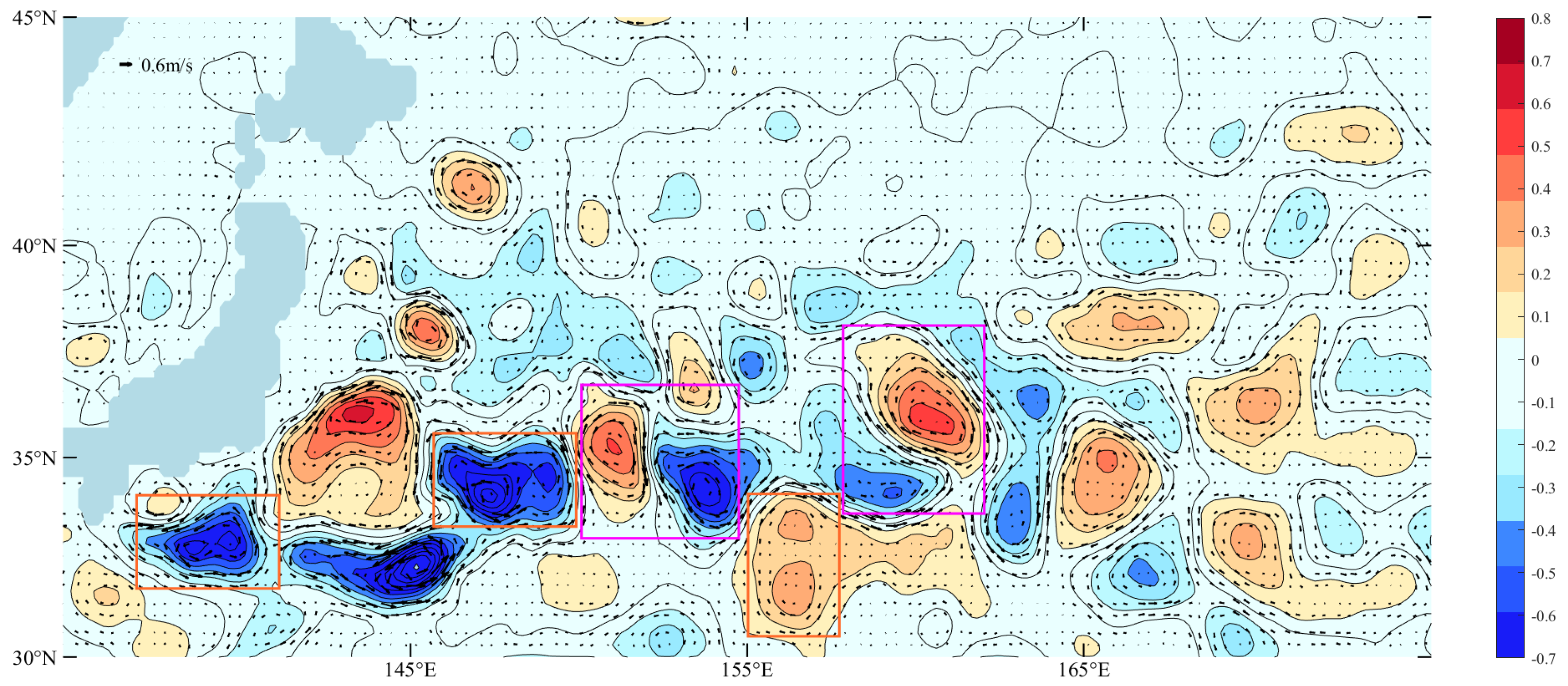
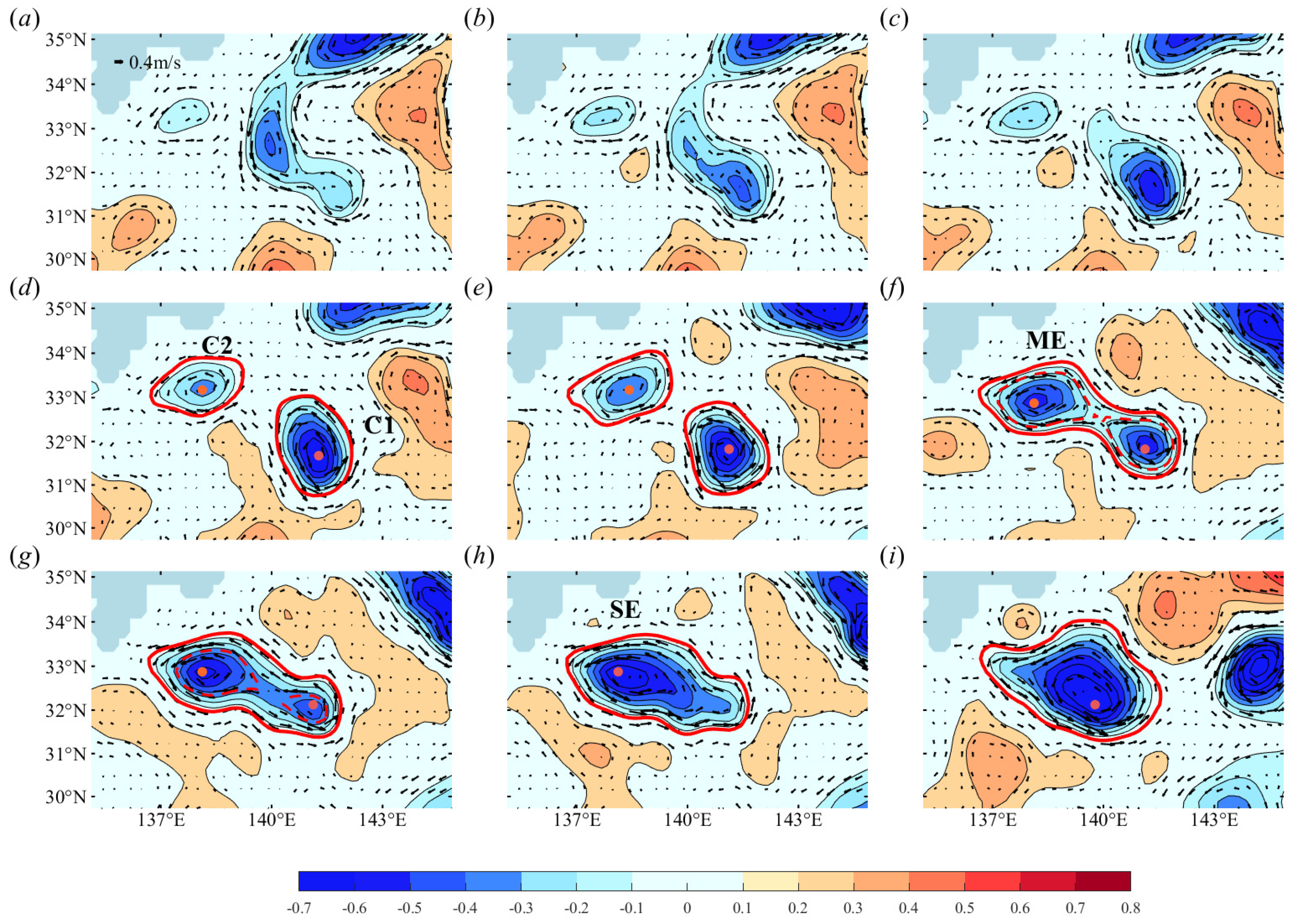


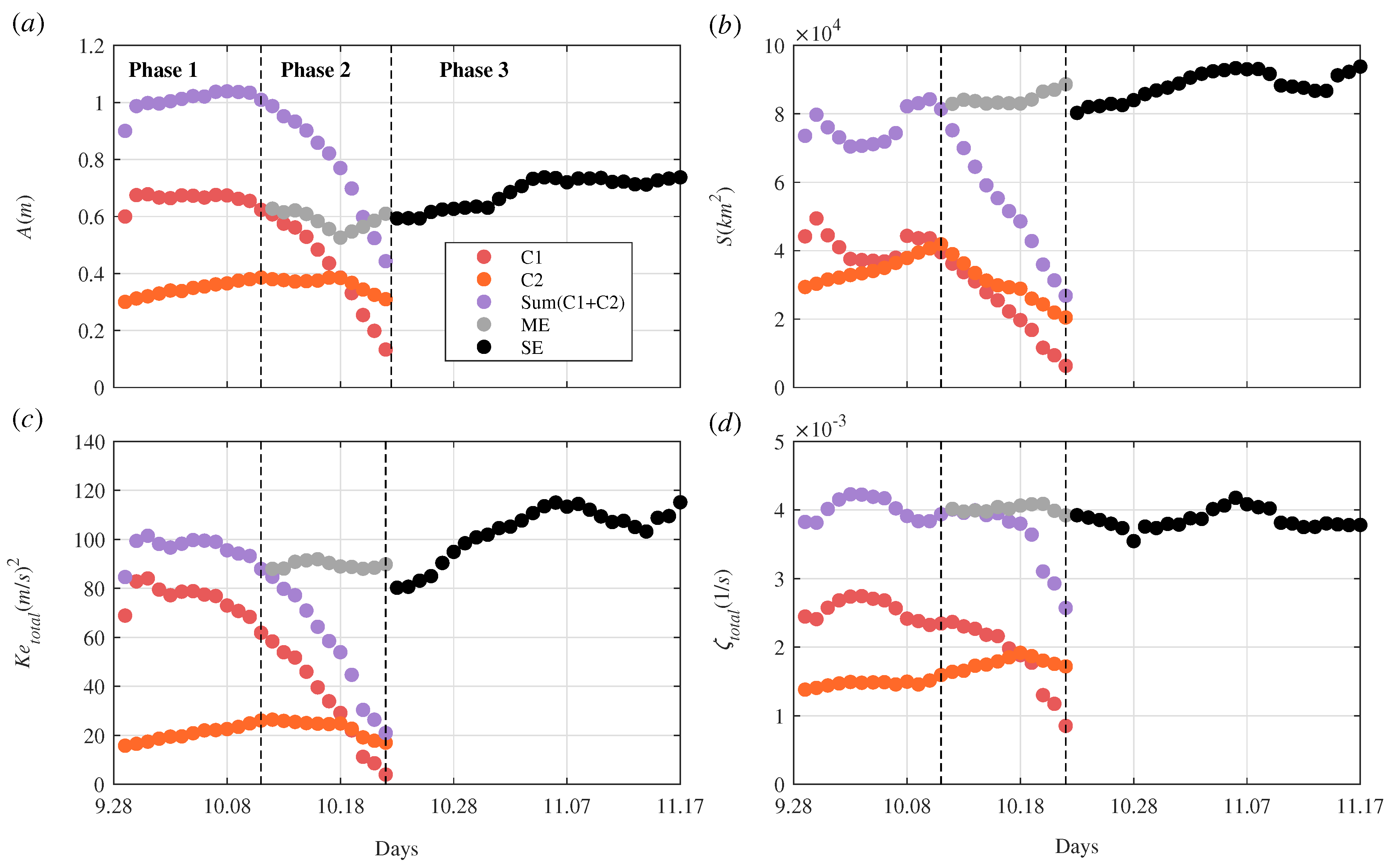
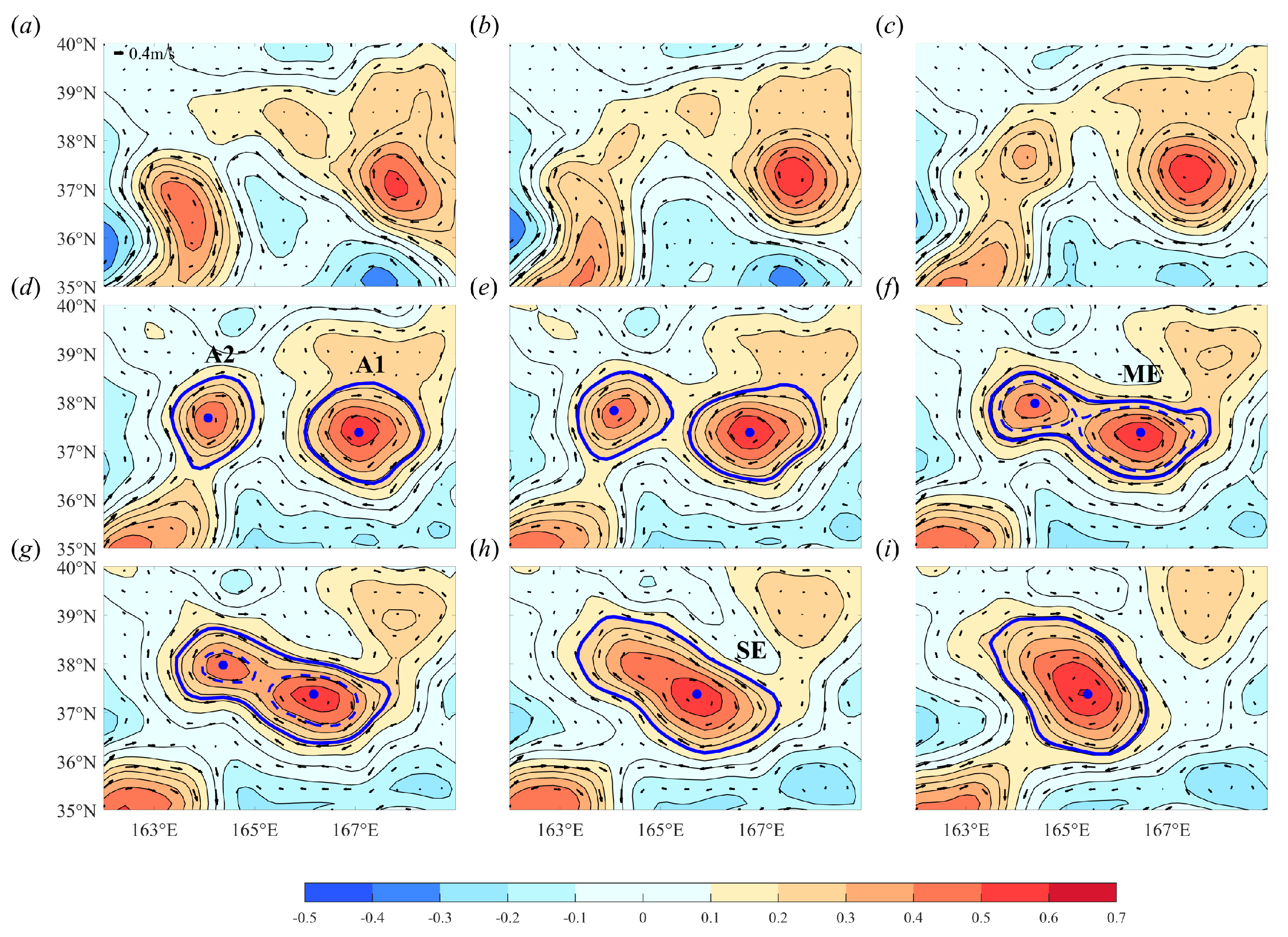
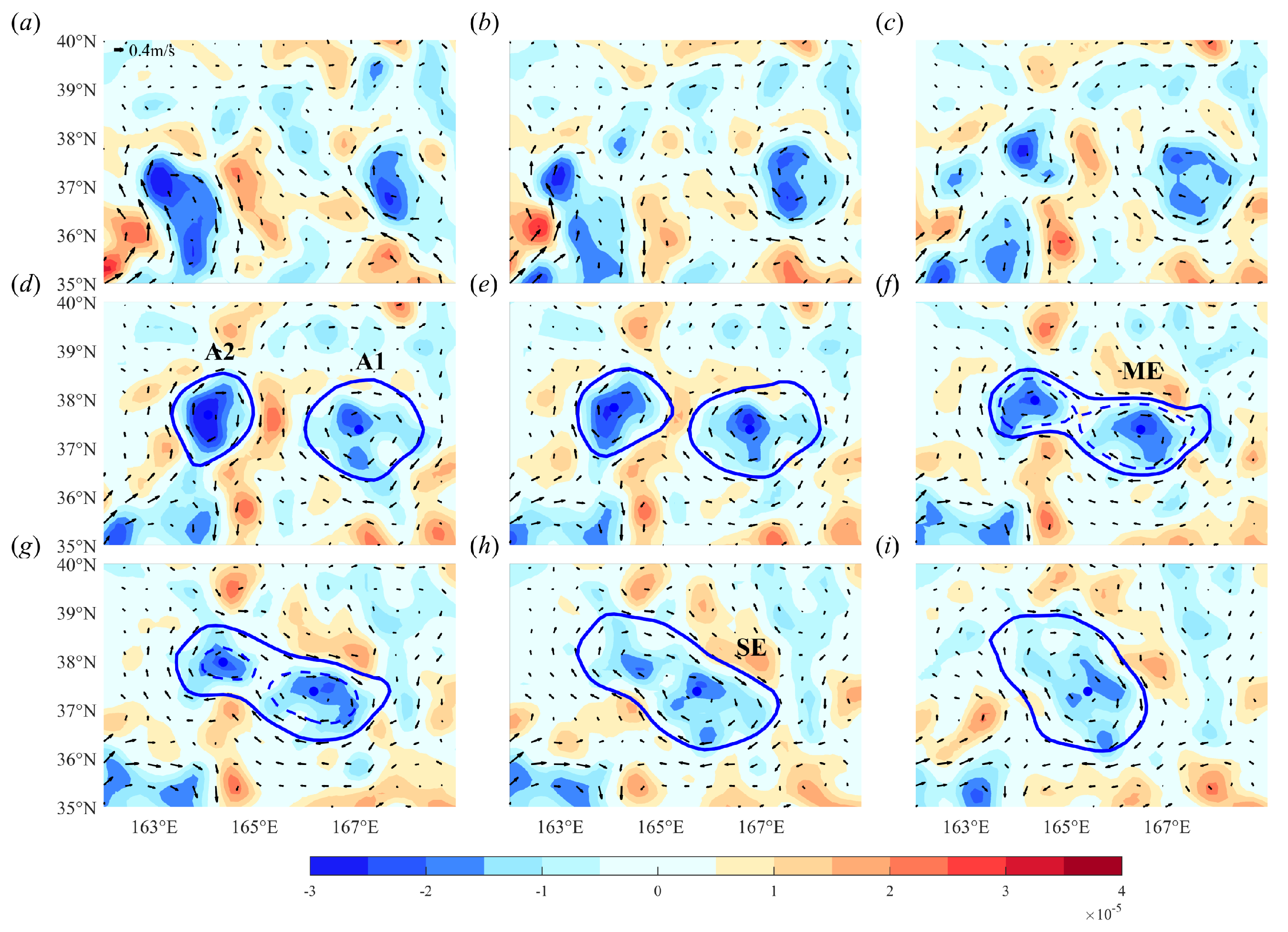
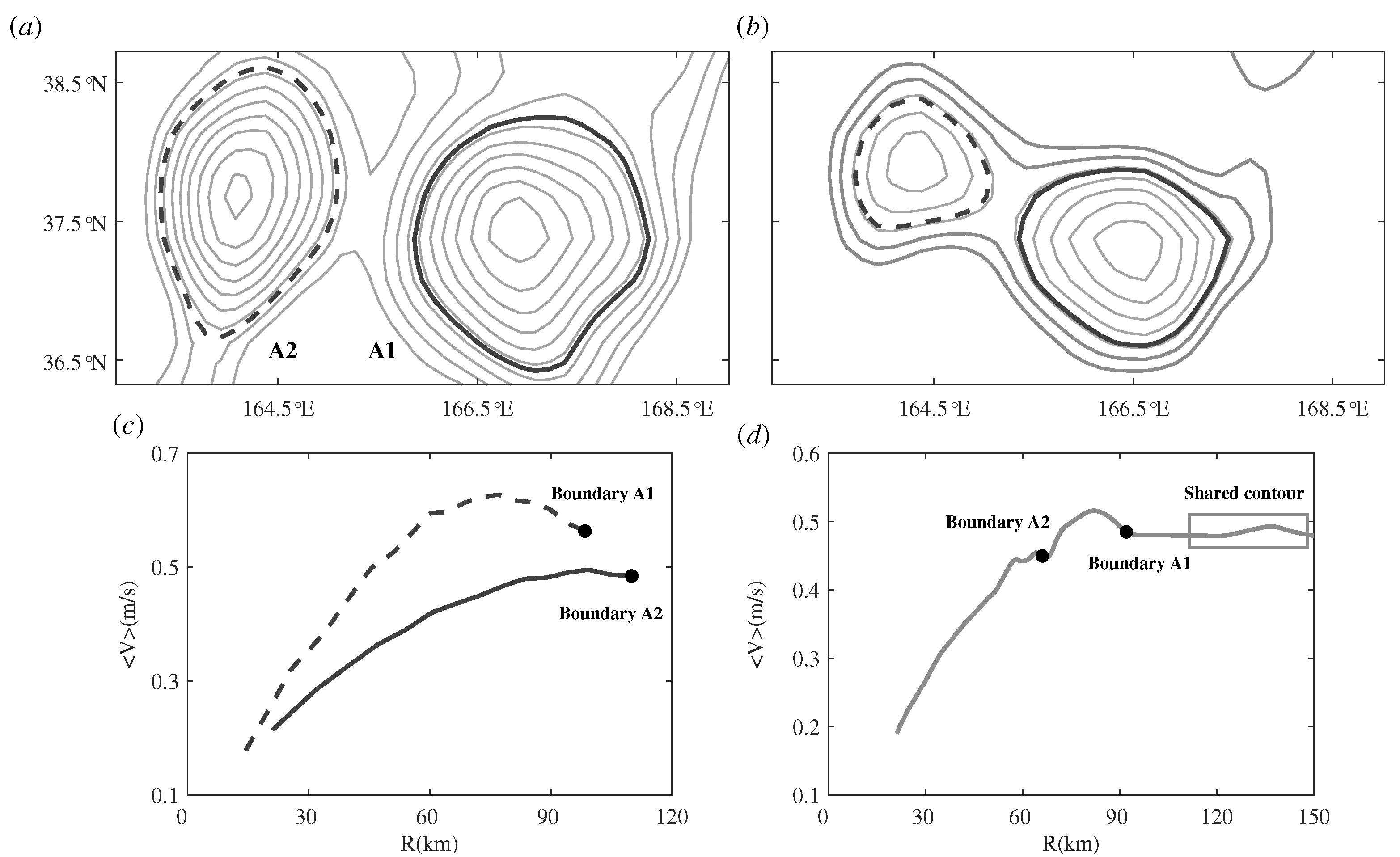
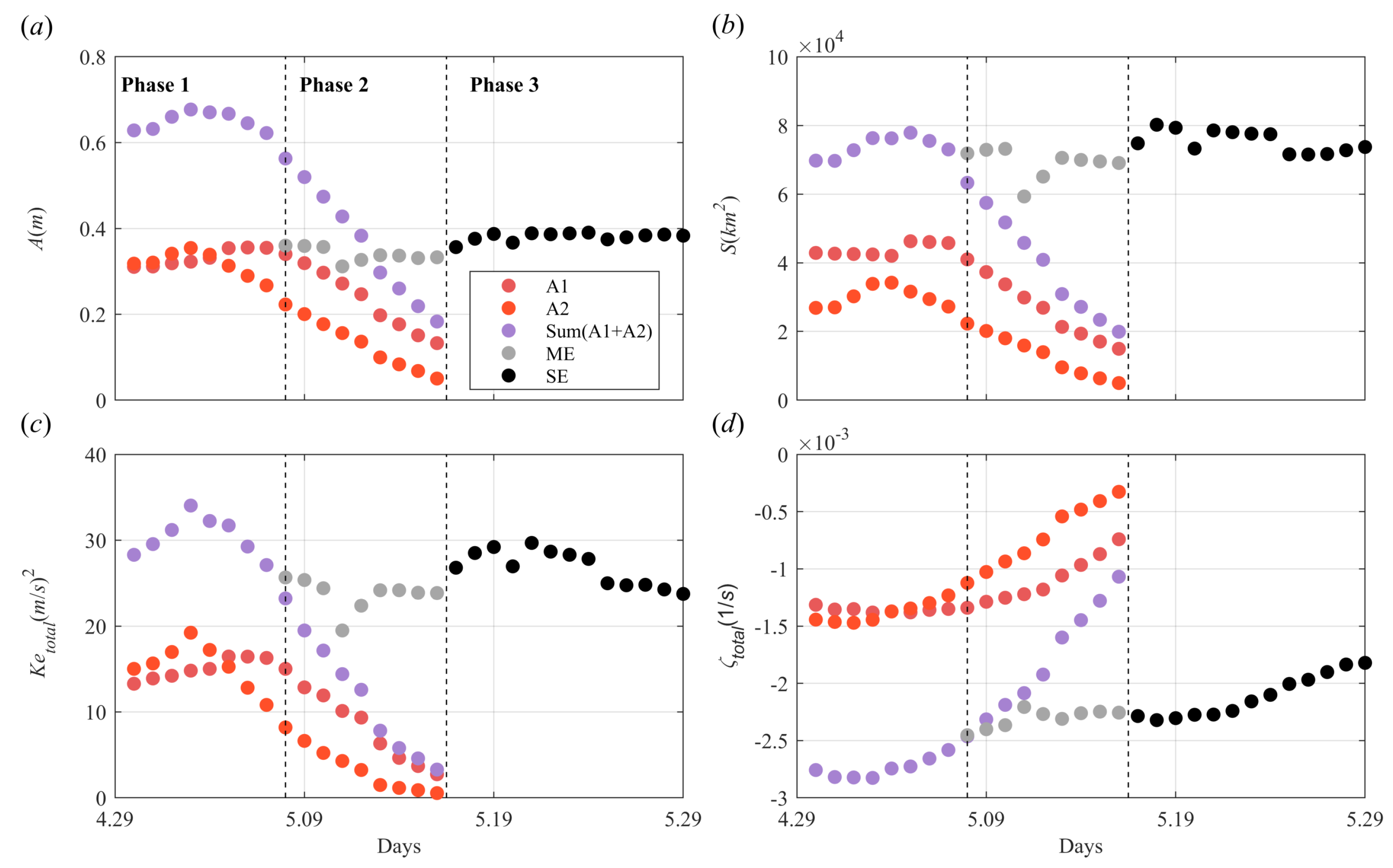
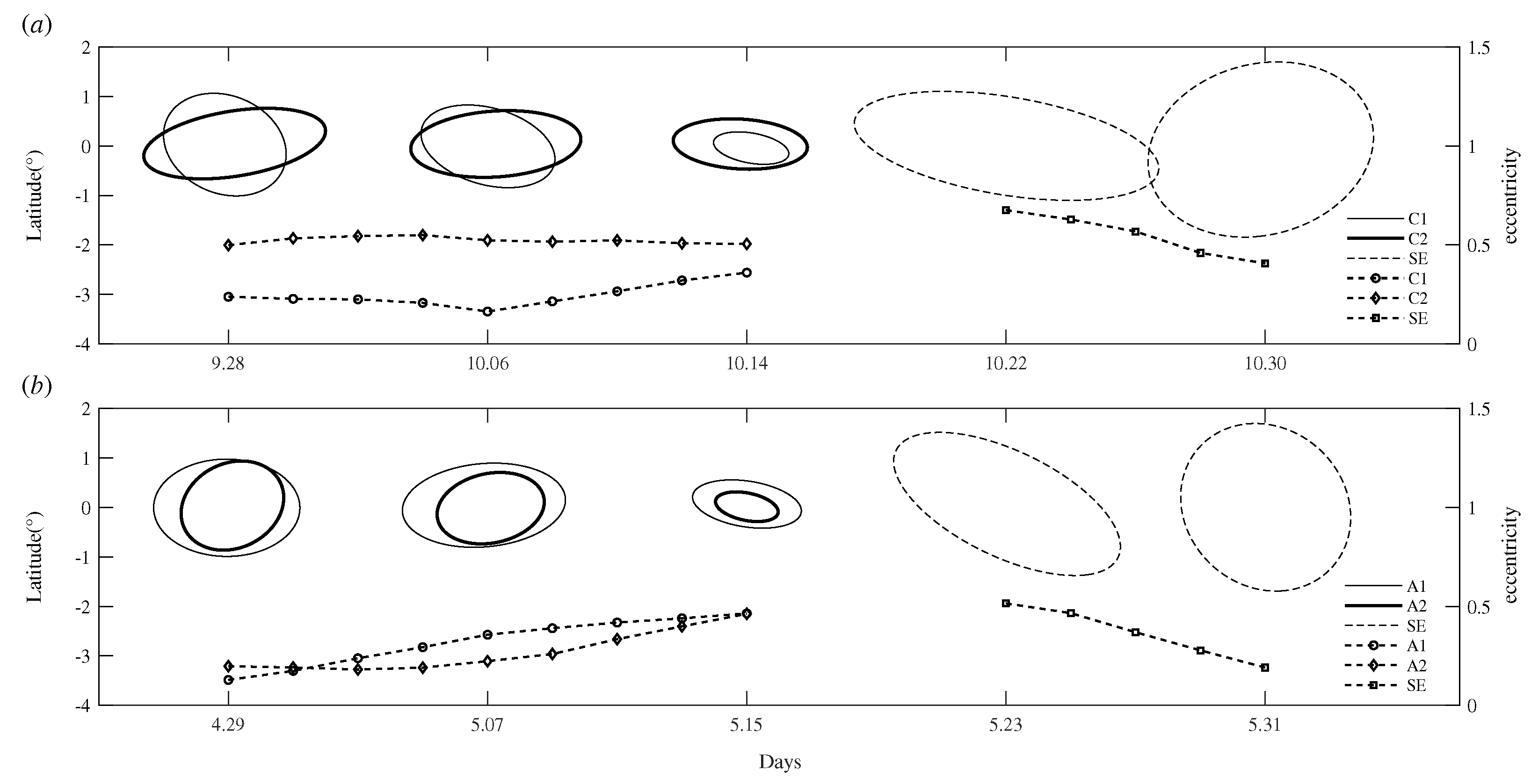
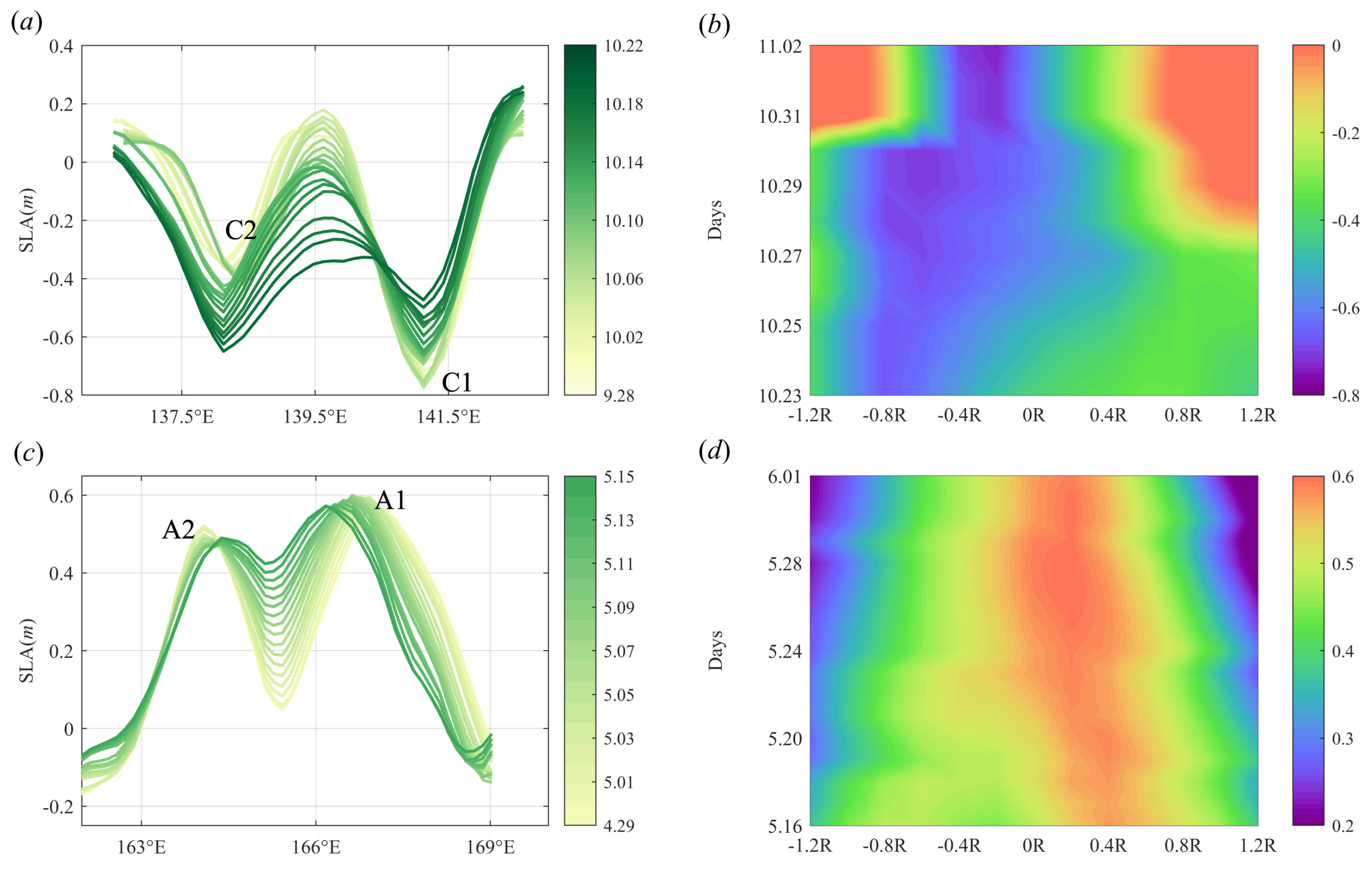
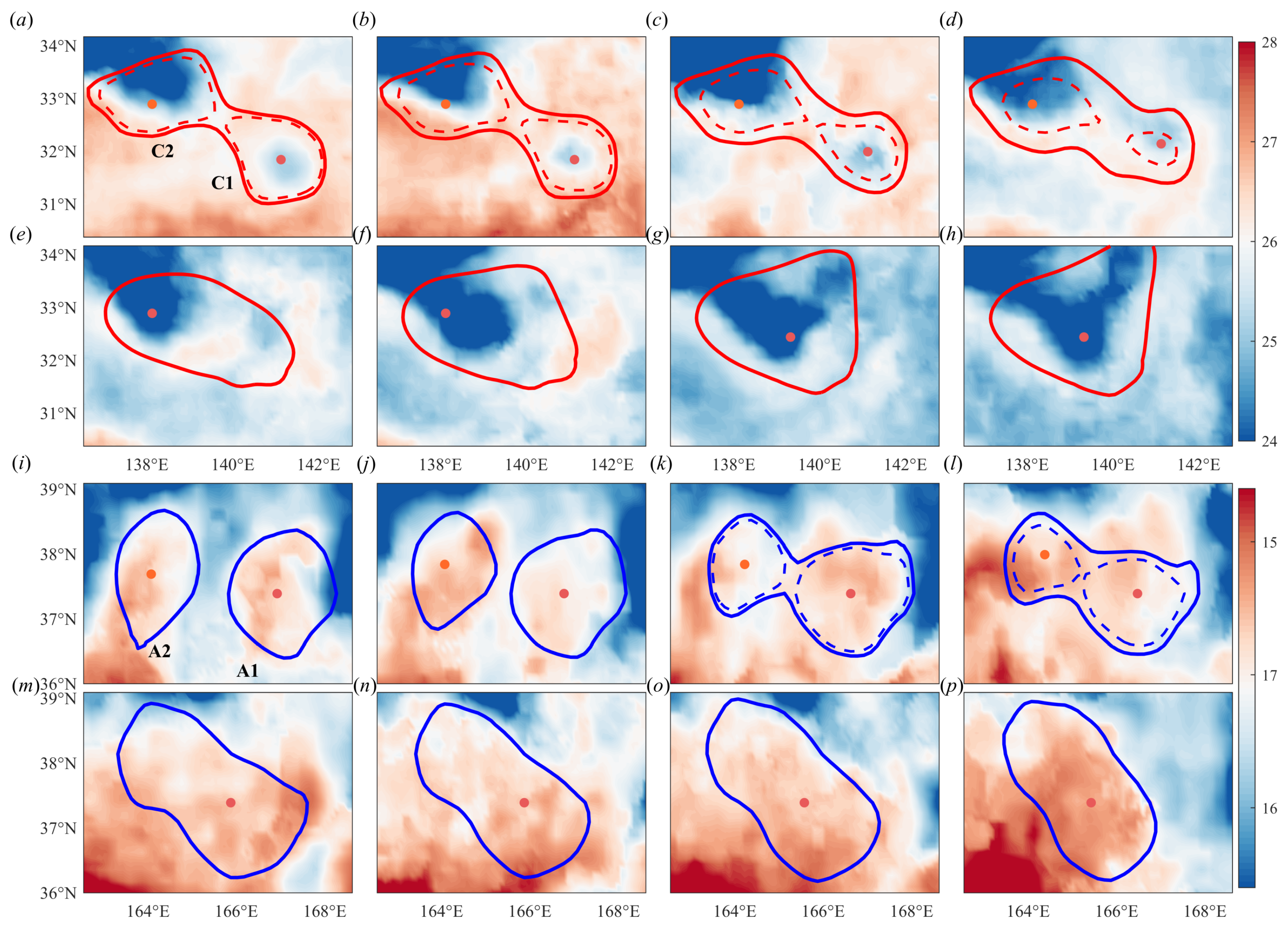
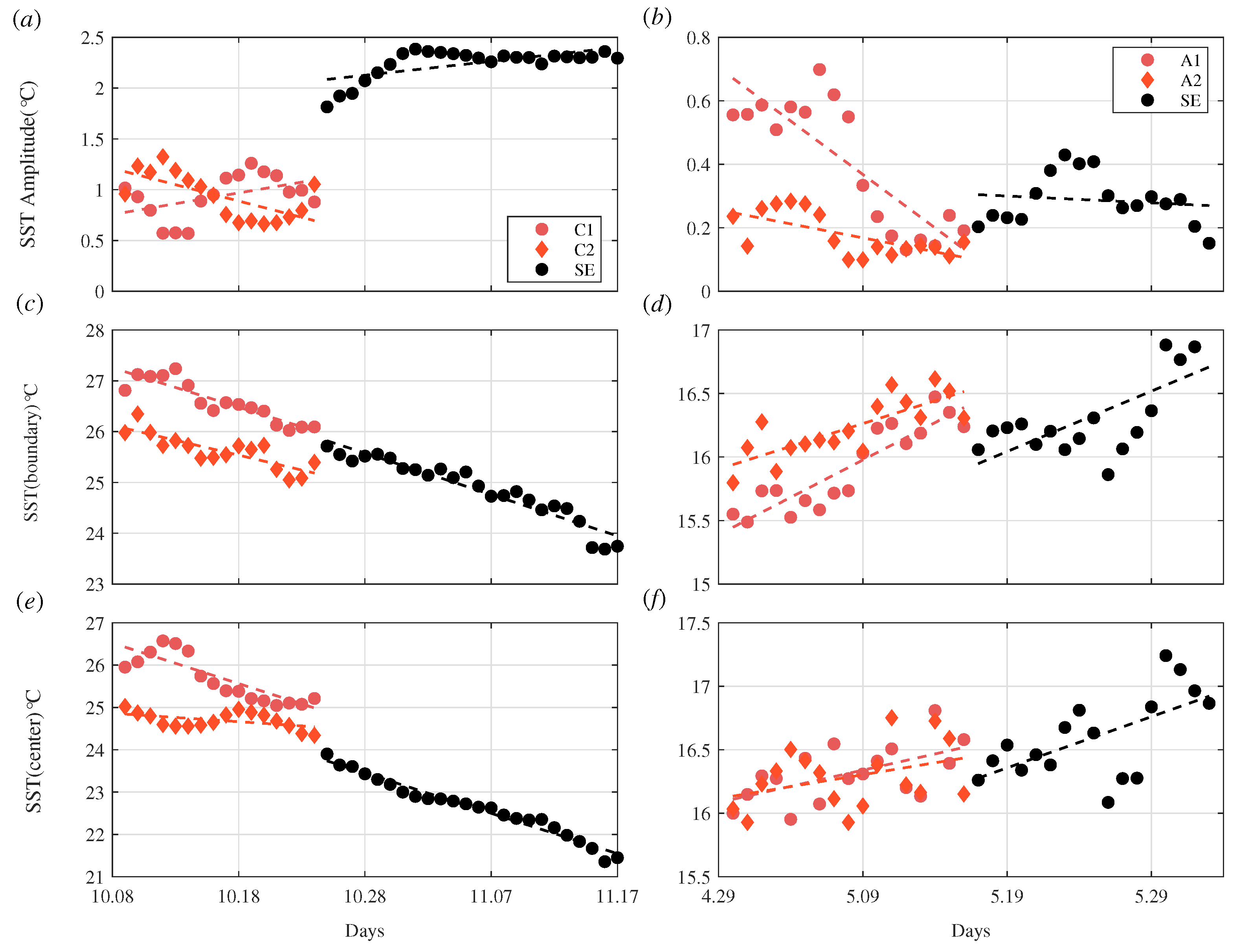

Disclaimer/Publisher’s Note: The statements, opinions and data contained in all publications are solely those of the individual author(s) and contributor(s) and not of MDPI and/or the editor(s). MDPI and/or the editor(s) disclaim responsibility for any injury to people or property resulting from any ideas, methods, instructions or products referred to in the content. |
© 2023 by the authors. Licensee MDPI, Basel, Switzerland. This article is an open access article distributed under the terms and conditions of the Creative Commons Attribution (CC BY) license (https://creativecommons.org/licenses/by/4.0/).
Share and Cite
Fu, M.; Dong, C.; Dong, J.; Sun, W. Analysis of Mesoscale Eddy Merging in the Subtropical Northwest Pacific Using Satellite Remote Sensing Data. Remote Sens. 2023, 15, 4307. https://doi.org/10.3390/rs15174307
Fu M, Dong C, Dong J, Sun W. Analysis of Mesoscale Eddy Merging in the Subtropical Northwest Pacific Using Satellite Remote Sensing Data. Remote Sensing. 2023; 15(17):4307. https://doi.org/10.3390/rs15174307
Chicago/Turabian StyleFu, Minghan, Changming Dong, Jihai Dong, and Wenjin Sun. 2023. "Analysis of Mesoscale Eddy Merging in the Subtropical Northwest Pacific Using Satellite Remote Sensing Data" Remote Sensing 15, no. 17: 4307. https://doi.org/10.3390/rs15174307
APA StyleFu, M., Dong, C., Dong, J., & Sun, W. (2023). Analysis of Mesoscale Eddy Merging in the Subtropical Northwest Pacific Using Satellite Remote Sensing Data. Remote Sensing, 15(17), 4307. https://doi.org/10.3390/rs15174307







